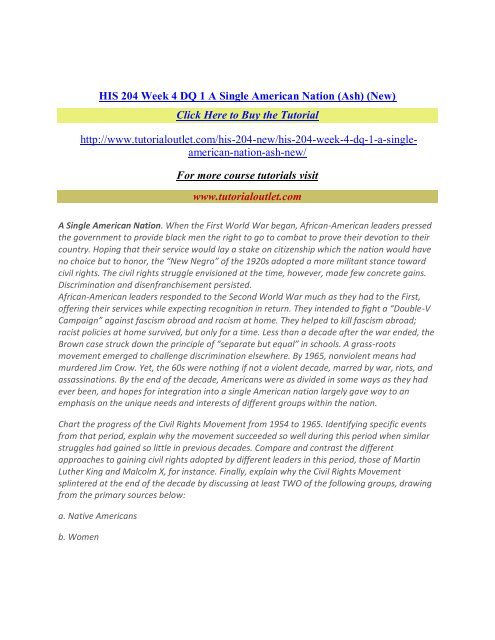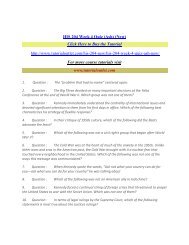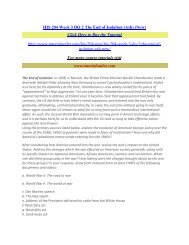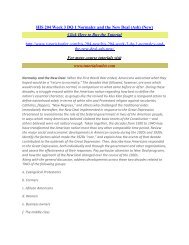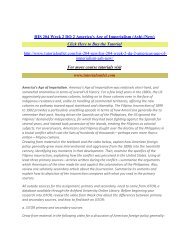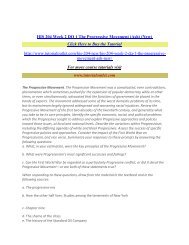HIS 204 Week 4 DQ 1 A Single American Nation (Ash) (New) / Tutorialoutlet
For more course tutorials visit www.tutorialoutlet.com A Single American Nation. When the First World War began, African-American leaders pressed the government to provide black men the right to go to combat to prove their devotion to their country. Hoping that their service would lay a stake on citizenship which the nation would have no choice but to honor, the “New Negro” of the 1920s adopted a more militant stance toward civil rights. The civil rights struggle envisioned at the time, however, made few concrete gains. Discrimination and disenfranchisement persisted. African-American leaders responded to the Second World War much as they had to the First, offering their services while expecting recognition in return. They intended to fight a “Double-V Campaign” against fascism abroad and racism at home. They helped to kill fascism abroad; racist policies at home survived, but only for a time. Less than a decade after the war ended, the Brown case struck down the principle of “separate but equal” in schools. A grass-roots movement emerged to challenge discrimination elsewhere. By 1965, nonviolent means had murdered Jim Crow. Yet, the 60s were nothing if not a violent decade, marred by war, riots, and assassinations. By the end of the decade, Americans were as divided in some ways as they had ever been, and hopes for integration into a single American nation largely gave way to an emphasis on the unique needs and interests of different groups within the nation. Chart the progress of the Civil Rights Movement from 1954 to 1965. Identifying specific events from that period, explain why the movement succeeded so well during this period when similar struggles had gained so little in previous decades. Compare and contrast the different approaches to gaining civil rights adopted by different leaders in this period, those of Martin Luther King and Malcolm X, for instance. Finally, explain why the Civil Rights Movement splintered at the end of the decade by discussing at least TWO of the following groups, drawing from the primary sources below: a. Native Americans b. Women
For more course tutorials visit
www.tutorialoutlet.com
A Single American Nation. When the First World War began, African-American leaders pressed the government to provide black men the right to go to combat to prove their devotion to their country. Hoping that their service would lay a stake on citizenship which the nation would have no choice but to honor, the “New Negro” of the 1920s adopted a more militant stance toward civil rights. The civil rights struggle envisioned at the time, however, made few concrete gains. Discrimination and disenfranchisement persisted.
African-American leaders responded to the Second World War much as they had to the First, offering their services while expecting recognition in return. They intended to fight a “Double-V Campaign” against fascism abroad and racism at home. They helped to kill fascism abroad; racist policies at home survived, but only for a time. Less than a decade after the war ended, the Brown case struck down the principle of “separate but equal” in schools. A grass-roots movement emerged to challenge discrimination elsewhere. By 1965, nonviolent means had murdered Jim Crow. Yet, the 60s were nothing if not a violent decade, marred by war, riots, and assassinations. By the end of the decade, Americans were as divided in some ways as they had ever been, and hopes for integration into a single American nation largely gave way to an emphasis on the unique needs and interests of different groups within the nation.
Chart the progress of the Civil Rights Movement from 1954 to 1965. Identifying specific events from that period, explain why the movement succeeded so well during this period when similar struggles had gained so little in previous decades. Compare and contrast the different approaches to gaining civil rights adopted by different leaders in this period, those of Martin Luther King and Malcolm X, for instance. Finally, explain why the Civil Rights Movement splintered at the end of the decade by discussing at least TWO of the following groups, drawing from the primary sources below:
a. Native Americans
b. Women
- No tags were found...
Create successful ePaper yourself
Turn your PDF publications into a flip-book with our unique Google optimized e-Paper software.
<strong>HIS</strong> <strong>204</strong> <strong>Week</strong> 4 <strong>DQ</strong> 1 A <strong>Single</strong> <strong>American</strong> <strong>Nation</strong> (<strong>Ash</strong>) (<strong>New</strong>)<br />
Click Here to Buy the Tutorial<br />
http://www.tutorialoutlet.com/his-<strong>204</strong>-new/his-<strong>204</strong>-week-4-dq-1-a-singleamerican-nation-ash-new/<br />
For more course tutorials visit<br />
www.tutorialoutlet.com<br />
A <strong>Single</strong> <strong>American</strong> <strong>Nation</strong>. When the First World War began, African-<strong>American</strong> leaders pressed<br />
the government to provide black men the right to go to combat to prove their devotion to their<br />
country. Hoping that their service would lay a stake on citizenship which the nation would have<br />
no choice but to honor, the “<strong>New</strong> Negro” of the 1920s adopted a more militant stance toward<br />
civil rights. The civil rights struggle envisioned at the time, however, made few concrete gains.<br />
Discrimination and disenfranchisement persisted.<br />
African-<strong>American</strong> leaders responded to the Second World War much as they had to the First,<br />
offering their services while expecting recognition in return. They intended to fight a “Double-V<br />
Campaign” against fascism abroad and racism at home. They helped to kill fascism abroad;<br />
racist policies at home survived, but only for a time. Less than a decade after the war ended, the<br />
Brown case struck down the principle of “separate but equal” in schools. A grass-roots<br />
movement emerged to challenge discrimination elsewhere. By 1965, nonviolent means had<br />
murdered Jim Crow. Yet, the 60s were nothing if not a violent decade, marred by war, riots, and<br />
assassinations. By the end of the decade, <strong>American</strong>s were as divided in some ways as they had<br />
ever been, and hopes for integration into a single <strong>American</strong> nation largely gave way to an<br />
emphasis on the unique needs and interests of different groups within the nation.<br />
Chart the progress of the Civil Rights Movement from 1954 to 1965. Identifying specific events<br />
from that period, explain why the movement succeeded so well during this period when similar<br />
struggles had gained so little in previous decades. Compare and contrast the different<br />
approaches to gaining civil rights adopted by different leaders in this period, those of Martin<br />
Luther King and Malcolm X, for instance. Finally, explain why the Civil Rights Movement<br />
splintered at the end of the decade by discussing at least TWO of the following groups, drawing<br />
from the primary sources below:<br />
a. Native <strong>American</strong>s<br />
b. Women
c. The Black Power movement<br />
d. Chicanos<br />
e. Students<br />
Summarize your response by considering the following questions:<br />
a. What precisely did the Civil Right Movement gain?<br />
b. What objectives did it fail to achieve?<br />
c. Why did so many new movements emerge by the end of the 1960s?<br />
d. Was the nation more or less divided in 1970 than it had been in 1950?<br />
When writing your response, draw from material in the following video:<br />
a. Let freedom ring: Moments from the civil rights movement, 1954-1965<br />
Also in your response, draw from at least TWO of the documents listed below:<br />
a. “The bottom of the economic totem pole”: African <strong>American</strong> women in the workplace<br />
b. The Port Huron statement of the students for a democratic society<br />
c. “The cycle of poverty”: Mexican-<strong>American</strong> migrant farmworkers testify before Congress<br />
d. “We must destroy the capitalistic system which enslaves us”: Stokely Carmichael advocates<br />
black revolution<br />
e. “Self determination of free peoples”: Founding documents of the <strong>American</strong> Indian Movement<br />
(AIM)<br />
f. “All our problems stem from the same sex based myths”: Gloria Steinem delineates <strong>American</strong><br />
gender myths during ERA hearings<br />
g. Gay power comes to Sheridan Square<br />
Your initial post should be at least 200 words in length. Support your claims with examples from<br />
the required material(s) and/or other scholarly resources, and properly cite any references.<br />
Respond to at least two of your classmates’ posts by Day 7 in at least 100 words. When
esponding to classmates, you should refer to the material from one of the sources which you<br />
did not reference in your initial post.


